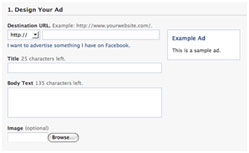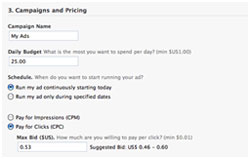A couple weeks back I had the distinct pleasure of heading out on a Midwest road trip with our Pres/CEO Grant Johnson. We were making stops to see clients in Chicago, Grand Rapids, Lansing and Detroit. We journeyed through the great state of Michigan by car and Grant came well prepared with his Ipod packed with 4,000 plus songs. Continue reading
Advertising
Use Facebook Ads to Promote Your Brand (HOW-TO)
Over the years, Facebook has evolved from a “yearbook” of sorts for college students to a full-fledged, 400 million user strong social networking site. As any marketing and advertising professional would tell you, the possibility of members from your target market having a Facebook account is relatively high. Luckily for you, Facebook’s advertising platform is easy to use and offers an analytics dashboard to help you track and measure your investment. If you are interested in advertising your brand on Facebook, then this guide is for you. Follow these easy steps and you will be advertising your brand on Facebook and seeing results in no time.
Identify Your Goals
Before creating your ad, targeting you should first think about what you want to accomplish. Some goals we’ve seen in the past include generating revenue, increasing cost per sale, or simply promoting your brand by maximizing visibility. It’s important to think about what you hope to gain so you can accurately measure your return and decide if it’s worth the time and resources.
Design and Develop
 Ad Copy and Creative– After you think about what you’d like to accomplish by advertising on Facebook, it’s time to create the ad itself. Facebook advertisements are located in the far right hand column of the screen after navigating away from the newsfeed. Ads are composed of a headline, copy and imagery to go with your theme. Imagery should be compelling and on-topic. It’s strongly suggested that in any type of online advertising, you use a creative featuring a person’s headshot- they tend to perform better than an object or lesser-known brand logo. In terms of copy, the titles can be 25 characters in length and the body copy of the ad can be 135 characters. It’s best to keep your copy short and to the point – let the imagery you choose do the talking.
Ad Copy and Creative– After you think about what you’d like to accomplish by advertising on Facebook, it’s time to create the ad itself. Facebook advertisements are located in the far right hand column of the screen after navigating away from the newsfeed. Ads are composed of a headline, copy and imagery to go with your theme. Imagery should be compelling and on-topic. It’s strongly suggested that in any type of online advertising, you use a creative featuring a person’s headshot- they tend to perform better than an object or lesser-known brand logo. In terms of copy, the titles can be 25 characters in length and the body copy of the ad can be 135 characters. It’s best to keep your copy short and to the point – let the imagery you choose do the talking.
Landing Page- After clicking on your compelling, well-written advertisement, the user is taken to a landing page where they will decide whether or not they will buy your product. Facebook ads can link to either a Fan Page or an external website. After managing the online ad campaigns for numerous clients, we’ve found that an external, campaign-specific landing page outperforms linking to your brand’s Fan Page. Taking that into consideration, it’s important to keep brand messaging consistent between the creative and the landing page. If your ad uses a logo or object as imagery, add it to your landing page so the user doesn’t feels confident that they clicked on the right advertisement.
Target Your Audience
 One of the many useful features of the Facebook advertising platform is the ability to target your advertising to specific segments. On Facebook, it’s possible to target:
One of the many useful features of the Facebook advertising platform is the ability to target your advertising to specific segments. On Facebook, it’s possible to target:
|
|
The ability to target your audience using this much detail makes advertising as effective, or even more effective, than PPC or traditional online display advertising. With a well thought out goal (remember step one?) and proper targeting, you’ve already qualified traffic to your landing page.
Define Cost Structure
 Defining goals, developing effective creative, and targeting your audience is nothing new. It’s been done since the beginning of advertising and is a standard procedure when launching any new campaign. Where advertising on Facebook, or anywhere online for that matter, differs from traditional media buying, however, is in the cost structure. There are two ways to manage your ad spend when running media on Facebook:
Defining goals, developing effective creative, and targeting your audience is nothing new. It’s been done since the beginning of advertising and is a standard procedure when launching any new campaign. Where advertising on Facebook, or anywhere online for that matter, differs from traditional media buying, however, is in the cost structure. There are two ways to manage your ad spend when running media on Facebook:
- Cost Per Click– You pay every time a user clicks on your advertisement. It doesn’t matter whether your ad was served 100 times or 1 million times, you only pay for every click.
- Cost Per Impression– You pay for a set number of impressions, or, ad views. This is measured in multiples of 1,000 and is called a CPM or “cost per million” ad spend.
Choosing a price structure that’s right for you is critical to the success of your campaign. If your goal is to increase brand recognition and don’t have any commercially-tied reason to drive traffic to your landing page other than to promote your name, choosing a CPM model would be the most cost effective. If, however, your success is measured by the number of sales you get via the landing page, starting off with CPC and calculating return would be well-advised.
Launch, Measure, and Repeat
 After deciding which cost structure is best suited to your goal, it’s time to launch. Run your ad and regularly monitor it using the dashboard under the “Ads and Pages” tab. Here, you’ll get detailed information on metrics such as bid cost, the number of clicks, average cost-per-click, and more. Narrow down your dashboard by selecting monthly, weekly, or even daily statistics, and dig deeper by exporting reports into csv format and analyzing historical trends.
After deciding which cost structure is best suited to your goal, it’s time to launch. Run your ad and regularly monitor it using the dashboard under the “Ads and Pages” tab. Here, you’ll get detailed information on metrics such as bid cost, the number of clicks, average cost-per-click, and more. Narrow down your dashboard by selecting monthly, weekly, or even daily statistics, and dig deeper by exporting reports into csv format and analyzing historical trends.
After running your ad for a few days, tweak the copy or swap the image and run both ads to find a winner. Running split tests will enable you to find out what works, and what doesn’t work for your audience. If you notice a positive return with advertising on Facebook, keep in mind the fact that users may get used to your ads after several impressions. Remember, marketing is an iterative process, and creativity is king so we always urge our clients to be constantly tweaking their advertisements even after they’ve found one that works.
StorySelling as an Effective Sales Closing Technique (Part 1)
Does the name Dick Fosbury sound familiar?
If you are a sports fan, a tad bit older and follow the Olympics, his name will be instantly recognizable. If not, here’s the background: Prior to Mr. Fosbury, most elite high-jumpers used the Straddle technique, Western Roll, Eastern cut-off or even Scissors-Jump to clear the bar. Everyone did the high jump the same way; they ran to the bar and rolled over the bar, face forward. Not Dick. He ran full steam ahead, contorted his body, turned and jumped backward at the bar just prior to take off, arching his back and lifting his legs over him. Everyone laughed. Until he broke all the records. He won the gold medal in the 1968 Summer Olympicsusing his technique.
Everyone was doing the high jump the perceived correct way; but Dick Fosbury and his “Fosbury Flop” showed everyone the right way to do it. The moral: the popular way is not necessarily the correct way. Every high-jumper today uses the “Fosbury Flop.”
It’s the same with StoryTelling. Lots of folks do it, but they could be doing it better by changing to StorySelling. This applies both to firms that use it and to any full service marketing agency that is hired to implement it on behalf of their clients.
This is the first of a three (3) part series on StorySelling: What, Why and How to do it correctly. When used properly, it’s an effective sales closing technique that will aid in soft selling your prospects. This first article will deal with WHAT StorySelling is and what makes it different from regular StoryTelling.
“StorySelling,” as I call it, is the art of telling an emotional and compelling story, regardless of medium, to effectively convey a call to action that sells a product or service, or gains a donation from the recipient.
A good story is something the recipient can read easily, relates with and which effectively touches that something inside of them but does not often urge them to take action. The key to your success is to go beyond the story and to think about your call to action, from the prospective audience(s) vantage point. It’s really more about gentle persuasion than overt selling when done correctly. That makes StoryTelling, StorySelling.
Here are some great StoryTellers:
- Music: Gordon Lightfoot, Harry Chapin, Bruce Springsteen, Bob Dylan
- Books: John Grisham, Shel Silverstein, James Patterson, Steven King
- Movies: James Cameron, Francis Ford Coppola, Woody Allen, Oliver Stone
- Plays: Andrew Lloyd-Webber, Arthur Miller, Tennessee Williams, Neil Simon
All great indeed but not StorySellers, any of them. If you look at Anthony Robbins, Oprah Winfrey, most seasoned politicians and legendary pitchmen, you’ll discover it.
It’s what made Billy Mays rich and Oxy Clean famous.
StorySelling is similar to full circle branding in that the story ends with a meaningful conclusion; in the case of measurable marketing a call to action to purchase or give. When done correctly both the advertiser and the responder win because ultimately they feel good, oftentimes excited about the action they just took. When done well, they go on to tell friends and they do the additional StorySelling for you.
Remember: People hate to be sold, but those same people love to buy, give or lend a hand. Great StorySelling then gives reasons for the recipient to take action. It incorporates purchasing options. In order to get to the call to action, it’s best to explain how the product or donation will help them or those who receive it. You need to lead with emotion and justify with logic. It’s the logic that takes the emotional StoryTelling to the next level of StorySelling.
Simply spend some time analyzing great infomercials and you’ll see what great StorySelling is about. Or, read ads from Oreck, Harry & David or Bose. They understand StorySelling. And, they are very successful.
We work with an important non-profit agency in southeastern Wisconsin that provides multiple social services to a wide variety of people. When we first became partners in direct mail campaigns with them, they were spending $25,000 per year on direct mail, and receiving about the same amount in return. Not-with-standing the potential lifetime value of the donors who made the gifts, this is still not the kind of return an agency executive wants to see.
We have been working with them for eight years now, and each of the direct mail pieces we have done for them has focused on an emotional, factual story of one element of their program. Of course, we have done considerable work in finding the right lists to target.
In those eight years, they have increased their annual direct mail expenditure to about $185,000 … with an annual return of more than $1 million! Now that’s a return a non-profit exec can get behind! That’s the power of StorySelling.
In the next article we’ll cover the reason WHY you need to be StorySelling today, right now.
Sincerely,
Grant Johnson
Founder, Johnson Direct
grant.johnson@johnsondirect.com
Hooters…a case of “Idiot Son Syndrome”
Has anyone out there watched the TV show called Undercover Boss on CBS? I caught the first episode featuring the CEO of Waste Management after the Super Bowl. I finally had the chance to sit down and watch the episode featuring the CEO of the Hooters restaurant chain. I know what you’re thinking. It had nothing to do with catching a glimpse of the scantily clad waitresses. I read in February that Hooters wasn’t doing well financially due to the recession and was shopping itself to a number of private-equity firms.
I’m sure the recession has some bearing on the financials of Hooters but after watching the episode I think Hooters suffers from what Don Libey affectionately calls “Idiot Son Syndrome!” While his late father started and successfully built up Hooters, the second generation son who took over the chain, obviously born with a silver spoon in his mouth, seemed clueless about the obvious reasons why the chain was having not just sales issues, but major morale issues with its people.
I could not believe how clueless the CEO was about the day-to-day operations of his business. For example, in one undercover assignment he worked at one of the company’s packaging plants and stated to one of the managers that he hadn’t set foot in the place since he was 17. The manager told him most of the people in the plant have never seen the new CEO and don’t even realize it’s the son! The son has to be in his mid to late 40’s. Where has he been the past 25 years? Collecting a pay check and playing with his toys instead of making himself visible….obviously.
In another segment of the show the CEO participates in a street promotion-handing out coupons to a new restaurant that just opened in Dallas-with two Hooters gals at his side. Doing this he hears positive but mostly negative feelings people have towards the restaurant chain. The CEO seemed concerned and rather surprised to hear these remarks. He must have ear muffs on for the past 10 years sheltering him from the feminist cries! Again clueless!
In today’s economic climate, CEOs and business leaders have to be visionaries and at the same time not afraid to roll up their sleeves and get to know all the facets of the business they are in charge of.
I’ll be placing a call into Hooters pronto. They could definitely use Johnson Direct’s PR Services!
Rob Trecek
Director of Business Development
rob.trecek@johnsondirect.com
Quality Counts, Too
Today’s BizTimes Milwaukee had an interesting story on a local non-profit leveraging social media networks to push it’s annual donation drive to younger donors. The article, “Use Social Media to Build Your Tribe”, reports that the campaign was successful, bringing in $12,460 of new donations. While the quantitative results of the campaign were positive, some organizations may look at the “small” number and think it’s not enough to cover the investment of time and resources. Those companies are wrong…
Social media isn’t just about quantity. It’s about starting the dialog with your audience. My strong belief is that the true measure of ROI in social media isn’t quantitative in nature, its qualitative. Engagement may very well be an overused, ill-defined buzzword, but the truth is that the number of followers you have, links you post or dollars you earn mean little unless you develop an ongoing relationship with those that show interest in your brand. Conversing with your audience and providing useful, relevant information so it can be shared with others will benefit you more in the long run.
Fortunately, the United Way of Greater Milwaukee got it right. The spokeswoman for the organization didn’t define success as the number of dollars raised, but said “the relationships we managed to build will be worth exponentially more in the future”. Bravo!